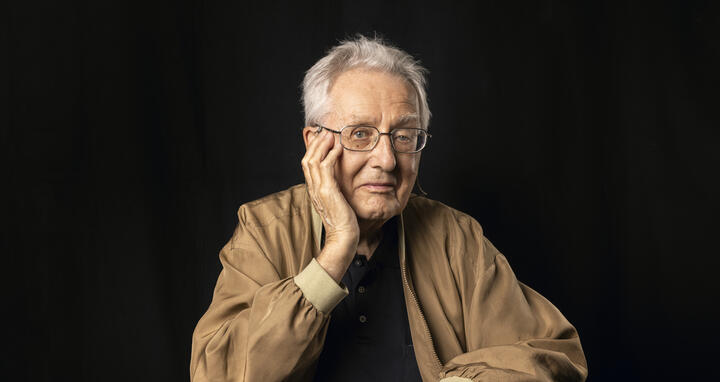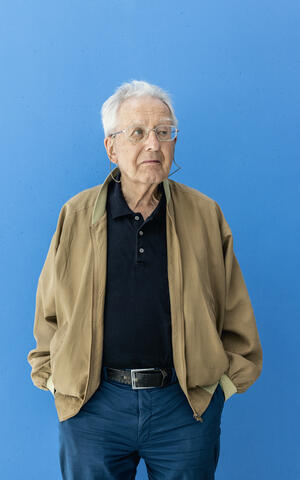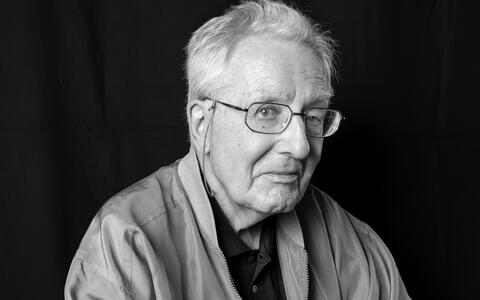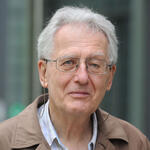The gene virtuoso
It was another “good” discovery: a refinement of the revolutionary CRISPR-Cas9 genetic scissors that make it possible to inactivate or repair diseased genes in DNA. An enzyme called nickase is used to cut the two strands of DNA – not with a single cut, but at two different points a specific distance apart. This avoids double-strand breaks, which can cause unwelcome reactions in cells. Dubbed “spacer-nick”, the refined genetic scissors radically reduce the chances of errors occurring when repairing a gene. They also reduce the risk of the DNA strand being cut in the wrong place. This could benefit future gene therapies for inherited diseases caused by a single defective gene, such as hemophilia.
“It’s good,” says Professor Klaus Rajewsky – and a “good” from Rajewsky can actually mean a lot more. Perhaps even “pioneering.” You could put this down to modesty on Rajewsky’s part, but it’s as much about the perspective that comes from spending a long life in research: “We think it’s potentially important. But technology moves on so quickly these days, you know?”
White-haired, with one pair of glasses on his nose and another hanging from a cord around his neck, Rajewsky is sitting at the meeting table in his office at the Max Delbrück Center for Molecular Medicine (MDC) in Berlin-Buch. He runs his hands across the table’s shiny veneer and talks about the past and present of genetics with a patience and exactitude that reveal a deep passion for his work.
Spacer-nick, which he and Dr. Van Trung Chu, along with researchers from his own and other MDC teams, presented in summer 2022 is just one of many projects that he is still actively involved in at 85 years of age. “Retirement? That’s a funny thing to ask. I never retired,” he replies with a straight face. “If your work’s exciting, there’s no real reason to stop.”
An exhilarating ride that’s still going strong
Rajewsky has spent six decades investigating the genetic mechanisms that underlie the immune system and allow diseases to develop. Six decades in which “lucky coincidences,” as he calls them, have occurred repeatedly. It’s an exhilarating ride that continues to this day. His 15-strong team at the MDC researches genetic methods and fundamentals in B cell development, and tumors and other diseases that can develop from B cells. Time and again, their work leads to “good” discoveries. In 2019, for instance, they showed that the expression of a self-reactive antigen receptor plays the key role in the differentiation of innate immune B cells. Rajewsky has to admit that the study, published in “Science”, was a kind of game changer. It’s one of roughly 230 articles that he has co-authored since he avoided having to retire at 65.
When this doyen of immunogenetics talks about the past, he glances down at the table as if he needs a neutral background from which to call forth the countless moments, situations, and people that have shaped him. People like the Nobel laureates François Jacob and Jacques Monod, for instance. Or Max Delbrück and Niels Jerne, also Nobel laureates. Rajewsky’s professional life reads like a chronicle of modern immunogenetics – a field that he has also guided and shaped over the course of his career.
From enzymes to the world of antibodies
It all began with lactate dehydrogenases, enzymes that drive metabolic processes in human cells. For his doctoral thesis, which he wrote while at the Institute for Chemistry at Goethe University Frankfurt, Rajewsky investigated how subforms of this enzyme arise. “I never answered that question. But I produced antibodies to analyze the subforms,” he says – and those antibodies quickly became more interesting than the enzymes. Rajewsky was fascinated by how diverse they were, how they could differentiate between self and foreign, how they developed “memory,” and could learn and improve over time. Becoming an immunologist was the only logical step from here.
And so, in 1962, he decided to move to the Institut Pasteur in Paris, where he joined the immunochemistry lab run by antibody specialist Pierre Grabar, a friend of his father’s, the biophysicist Boris Rajewsky. “In Paris, I found myself in an international atmosphere that was entirely new to me and completely different from postwar Germany,” he says. The 26-year-old would often sit engrossed in seminars held in the smoky, overcrowded laboratory of the later Nobel laureates Jacob und Monod. Electrified, he would follow the debates on gene regulation mechanisms in bacteria, despite only understanding a fraction of what was being said: “The way they openly and passionately discussed among each other had a profound effect on me.”
An immunologist among molecular biologists
You didn’t have to always say ‘Herr Professor.’ People dressed casually and chatted with each other. It was very liberating.
Rajewsky then returned to Germany, and in 1964 became a research assistant at the University of Cologne’s Institute for Genetics, which Max Delbrück had founded just a few years earlier. “I didn’t hesitate for a moment because I suspected the atmosphere would be similar to what I had experienced with Jacob and Monod,” he says. And he was right: Delbrück had built the institute in the American style, with small groups and flat hierarchies. “You didn’t have to always say ‘Herr Professor.’ People dressed casually and chatted with each other. It was very liberating.”
Delbrück came to Cologne for a few months every year to give lectures. Rajewsky was captivated by Delbrück’s rigor and his obsession with drilling down to the truth in his research. “He was only interested in the evidence. Nothing else. I’ve always tried to follow this line,” says Rajewsky. Although he never expected to stay so long, he spent 38 years at Delbrück’s institute – 31 of them as a professor of molecular genetics. When he left Cologne in 2001, his department was the largest in the institute, at times employing 76 people, many of whom continue to advance immunogenetics today.
“Whenever we pushed a door, it opened”
“Cologne was an incredible stroke of luck for me. I arrived in the right place at exactly the right time. Molecular biology was just developing and I was more or less the only immunologist there,” says Rajewsky. His antibody expertise was in demand at the institute, though he spent most of his time working on his immunological research. After two years, he founded a department for immunology and successfully acquired funding from the German Research Foundation and other sources. “The interface between molecular biology and immunology kept growing,” he says.
Scientists from all over the world came to Cologne to take Delbrück’s famous course on bacteriophages – viruses that infect bacteria. “Of the people who later made their mark on biochemistry and other areas of molecular biology in Germany, most came to Cologne at that time,” says Rajewsky. His department – or “our little universe” as he liked to call it – was also growing and becoming more international. Young researchers were arriving from Japan, China, the US, and France. “We were a great community and had an incredibly fruitful culture of discussion,” he says. “Whenever we pushed a door, it opened. Every experiment was something entirely new.” Together, he and his team did pioneering immunogenetic work on mice in a quest for fundamental knowledge. They explored questions such as how antibody-producing B cells develop from stem cells; how the B cells produce their antibodies; why there are different classes of antibody; and how antibodies develop their binding strength for the pathogens they are tasked with fighting.
Discovering a standard technology for genetics
An important door opened in 1991, when they proved that B cells train their antibodies in specialized cellular compartments known as germinal centers. Rajewsky’s team showed that antibodies mutate there to improve their binding sites so that they can fight off pathogens in a more targeted way. Soon after this, the team conducted molecular experiments on single cells and found that B cells are also at the origin of the then mysterious disease of Hodgkin’s lymphoma, a common type of lymphoma.
But perhaps the most important door opened in 1994, when Rajewsky’s team collaborated with Jamey Marth from Vancouver to breed the first mouse in which a genomic gene could be inactivated for a single cell type. With previous knockout mice, it had only been possible to inactivate genes in the germline – and therefore in all cells at once, which can have unpredictable or even fatal consequences. When the work was published, it triggered a revolution. Today, thousands of laboratories around the world use conditional mutagenesis as a standard genetic technology. It is also being continually developed so that researchers can investigate the role of genes in normal organisms and in the development of disease. “Suddenly, people from all over the world were coming to our lab to learn how to do it,” says Rajewsky. One way he and his team use this technology is to produce tumor models in mice m
A new start at Harvard at 65
Rajewsky never sought to become a dean, president of a university, or a research director. He wants to keep doing his work, not get ground down: “I’ve always resisted having my day planned from start to finish and being sucked into a machine. I need to be able to retreat so that I can think and switch off.”
When he began approaching retirement age, he felt uneasy: “My father only managed to delay his obligatory retirement by a few years. I really wanted to avoid that agony – I was in the midst of productive research.” Cologne offered him an additional two years. Already before that, Rajewsky was spending part of his time in Rome, where he was setting up the mouse program of the European Molecular Biology Laboratory (EMBL). Then came an offer he couldn’t refuse: a position at Harvard Medical School in Boston. And so, at 65, he made a new start, with many of his closest collaborators following him. Once again, he invested all his energy in researching B cells and tumors of the lymphatic system. He also added a new focus, investigating the role that the newly discovered microRNAs play in cell development. “It was a wonderful time,” he says.
More radical change – and in the thick of it again
Painting from the Berlin artist Jeanne Mammen
Rajewsky was 75 when the Max Delbrück Center offered him the chance to come back and research in Berlin – subject to evaluations, but with no age limit. “So I didn’t come here with emeritus status,” he says, and laughs the way he always does when he realizes something was a “lucky coincidence.” In his Berlin office, he’s hung a painting that spent decades with him in Cologne. Max Delbrück bought it from a friend, the Berlin artist Jeanne Mammen, in the 1960s. It’s of two figures, inspired by African art.
By now it was 2012, and another period of radical change had begun – similar to the time in Cologne when molecular biology was just beginning to blossom. Now, computer-based methods, big data, and artificial intelligence were turning the life sciences on their head. Rajewsky’s son Nikolaus was at the forefront of the action, founding the Berlin Institute for Medical Systems Biology (BIMSB) at the MDC. “A fascinating new world is opening up because you can now combine huge data sets and distill information from them in a way that we used to only be able to dream of,” says Rajewsky. “These days, you often don’t look at a single gene. You focus on the whole genome – on expression patterns of genes and genetic pathways, in cell aggregates or single cells.”
Shortly after arriving at the MDC, Rajewsky read an article in “Nature”, which would change the field of genetics again: it was the birth of the CRISPR-Cas9 genetic scissor. “That was an enormous step forward. We began working with it immediately,” says Rajewsky. The new technology made his conditional mutagenesis much easier to use because the required mutations could be inserted directly into the mice’s genetic material, instead of taking the circuitous route via embryonic stem cells.
Foundations for new gene therapies
Once again, Rajewsky is at the heart of the action. His team, often in collaboration with other teams, including clinically oriented research groups, now uses computer-aided methods and CRISPR-Cas to understand the genetic origins of diseases – for example, how infection by the Epstein-Barr virus, which attacks antibody-producing B cells, can lead to multiple sclerosis. Mouse models continue to provide starting points for new therapies, such as for multiple myeloma, a cancer arising in the bone marrow, or Burkitt’s lymphoma, an aggressive form of B cell lymphoma.
“We’re now also studying human cells, and we hope that we can help to further develop gene therapies,” says Rajewsky. But as ever, he remains focused on basic research. There are still plenty of new chapters to explore. Why would he stop? “I love tackling new things,” he says. And keeps on working.
Text: Mirco Lomoth
Further information
- A fine-tuned gene editor
- A life-or-death decision
- On the origin of B1 cells
- Immunology & Inflammation initiative
- Building “a small universe”: the very model of a laboratory (an interview with Klaus Rajewsky)
- Years in Cologne (a retrospective of Klaus Rajewsky’s work in Cologne)









